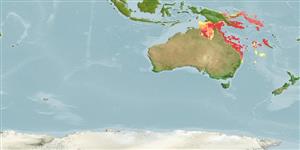Classification / Names
Common names from other countries
Main reference
Size / Weight / Age
Max length : 30.0 cm TL male/unsexed; (Ref. 9710); common length : 15.0 cm SL male/unsexed; (Ref. 3810)
Environment
Marine; reef-associated; depth range 10 - 70 m (Ref. 90102)
Climate / Range
Tropical, preferred ?; 3°S - 30°S, 135°E - 165°E (Ref. 3810)
Distribution
Western Pacific: northeastern Australia, southern Papua New Guinea, Solomon Islands and the Philippines. This species has been previously confused with Pentapodus setosus by most authors.
Countries | FAO areas | Ecosystems | Occurrences | Introductions
Short description
Dorsal
spines
(total): 10;
Dorsal
soft rays
(total): 9;
Anal
spines: 3;
Anal
soft rays: 7. Head scales reaching forward to or almost to level of posterior nostrils. Suborbital naked. Lower limb of preopercle naked. Pelvic fins short, not reaching to level of anus. Upper lobe of caudal fin produced into a very long trailing yellowish-brown filament. Axillary scale present. Color: Upper body pale brownish, lower whitish. Presence of three bluish stripes across snout, first joining eyes behind nostrils, second in front of nostrils, third from eye to tip of snout. A yellow stripe from behind eye to upper base of pectoral fin. A yellow stripe from middle of upper lip, beneath eye to below pectoral fin.
IUCN Red List Status (Ref. 115185)
Threat to humans
Harmless
Human uses
Fisheries: subsistence fisheries
More information
Common namesSynonymsMetabolismPredatorsEcotoxicologyReproductionMaturitySpawningFecundityEggsEgg development
ReferencesAquacultureAquaculture profileStrainsGeneticsAllele frequenciesHeritabilityDiseasesProcessingMass conversion
Tools
Special reports
Download XML
Internet sources
Estimates of some properties based on models
Phylogenetic diversity index
PD50 = 0.5002 many relatives (e.g. carps) 0.5 - 2.0 few relatives (e.g. lungfishes)
Trophic Level
3.7 ±0.54 se; Based on food items.
Resilience
High, minimum population doubling time less than 15 months (Preliminary K or Fecundity.)
Vulnerability
Low to moderate vulnerability (27 of 100)
Price category
